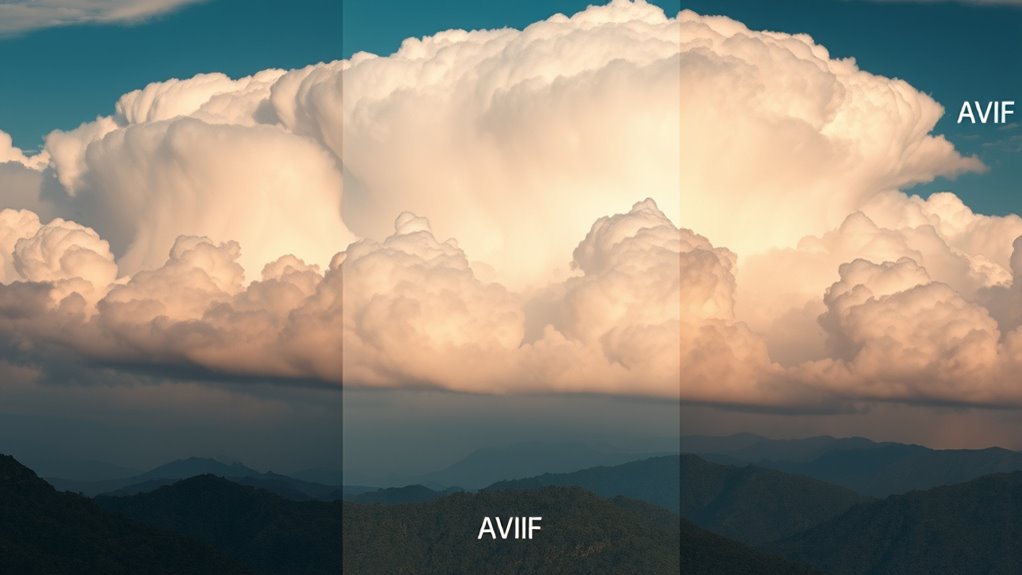Cloud photo formats like HEIF, HEIC, ProRAW, and AVIF offer advanced features, better compression, and richer visuals to optimize storage and sharing. HEIF and HEIC use efficient HEVC compression, reducing file sizes while maintaining quality, but compatibility can be a challenge. ProRAW provides maximum editing flexibility, and AVIF supports HDR and transparency with even better compression. Continue exploring to understand how these formats enhance your cloud storage and photo workflows.
Key Takeaways
- HEIF/HEIC, ProRAW, and AVIF are modern cloud-compatible photo formats optimized for efficient storage and high-quality visuals.
- HEIF/HEIC uses HEVC compression for smaller file sizes, supporting transparency, metadata, and editing features.
- AVIF offers superior compression efficiency, HDR support, and wider color gamut, making it ideal for high-quality cloud storage.
- ProRAW captures raw sensor data, providing maximum editing flexibility while balancing file size and image quality.
- Compatibility varies across devices and platforms, with ongoing improvements enhancing support for these advanced formats.
Overview of Modern Cloud Photo Formats

Modern cloud photo formats have revolutionized how we store, share, and access images online. These formats optimize storage efficiency and improve compatibility across devices and platforms. HEIF and HEIC are popular formats that store high-quality images at markedly reduced file sizes, thanks to advanced compression technologies. They support rich metadata, transparency, and multiple images within a single file, making them versatile for modern photography needs. Formats like ProRAW and AVIF also enhance flexibility, offering lossless or high-efficiency compression suited for professional workflows and high-resolution images. These formats are increasingly supported by operating systems and apps, enabling seamless integration into your digital ecosystem. Additionally, advanced compression techniques allow for even smaller file sizes while maintaining high image quality, further enhancing storage and sharing efficiency. Understanding format compatibility can help users choose the best options for their specific devices and needs. Moreover, staying informed about security concerns related to image formats ensures your data remains protected during storage and transfer. As the adoption of these formats continues to grow, developers are working on standardization efforts to ensure consistent support across platforms, simplifying user experience. By adopting these modern cloud photo formats, you benefit from faster uploads, easier sharing, and optimized storage without sacrificing image quality.
Understanding HEIF/HEIC Compression and Storage Techniques

Understanding how HEIF and HEIC files achieve their compact size requires exploring their advanced compression techniques. These formats leverage HEVC (H.265) video compression, which efficiently reduces file sizes by exploiting spatial and temporal redundancies within images and sequences. This adaptive compression predicts pixel data, minimizing storage needs without sacrificing much visual quality. For image sequences, compression shares data across frames, drastically reducing size. HEIF also supports lossy and lossless compression, giving you flexibility in balancing quality and storage. Metadata such as EXIF and XMP are preserved, maintaining image details without increasing size. Additionally, features like alpha channels and non-destructive editing instructions enable rich, high-quality images while keeping file sizes minimal. This sophisticated compression approach makes HEIF/HEIC ideal for cloud storage, optimizing space without compromising essential image information. Moreover, the ability to cultivate creativity in handling complex compression algorithms demonstrates the importance of innovation in digital image technology.
Advantages of HEIF/HEIC for Cloud Storage

HEIF and HEIC formats offer significant advantages for cloud storage by dramatically reducing file sizes without compromising essential image quality. This means you can store more photos in less space, saving costs and improving upload and download speeds. Their efficient compression techniques lower storage requirements by up to 60 percent compared to JPEGs, enabling faster backups and easier sharing. Additionally, HEIF/HEIC files preserve vital metadata, such as location and camera settings, which simplifies organization. The advanced compression also supports image sequences and multiple formats within a single file, reducing clutter. Plus, their compatibility with modern devices ensures seamless access across platforms. Furthermore, integrating AI-driven optimization can enhance image management and quality enhancement in cloud storage solutions. Employing such compression techniques can further optimize storage efficiency and image quality. Modern compatibility standards ensure these formats work effortlessly across various operating systems and applications. As technology advances, continuous improvements in format efficiency promise even greater storage savings and performance benefits. Overall, adopting HEIF/HEIC means you get high-quality images with minimal storage footprint, making cloud management more efficient and cost-effective. Additionally, ongoing technology development continues to improve these formats, ensuring they remain a forward-compatible choice for future devices and services.
Limitations and Compatibility Challenges of HEIF/HEIC

You might find that HEIF/HEIC files don’t work well on older devices or software, which can cause frustration when sharing or viewing images. Compatibility issues often require you to use third-party converters or updated apps, adding extra steps to your workflow. Additionally, while HEIF offers smaller file sizes, this sometimes comes at the expense of image quality, especially in complex or low-light scenes. Recognizing the well-sourced coverage of these formats emphasizes the importance of understanding their limitations for effective use. Moreover, file format compatibility remains a significant challenge, as not all platforms support HEIF/HEIC natively, necessitating additional tools or conversions.
Compatibility With Legacy Devices
While HEIF/HEIC formats offer advanced compression and rich features, compatibility with legacy devices remains a significant challenge. Older smartphones, tablets, and computers often lack native support for these formats, making it difficult to open or edit HEIF/HEIC images without additional software. Many early operating systems, including Windows versions prior to Windows 10, and older versions of macOS and Android, don’t support HEIF/HEIC out of the box. This discrepancy forces users to rely on third-party viewers or convert images to more widely supported formats like JPEG. Additionally, hardware limitations in outdated devices hinder playback or viewing of HEIF/HEIC files, leading to potential compatibility issues when sharing or storing images across different platforms. Understanding file format compatibility is crucial for seamless image sharing and management across diverse devices, especially when considering legacy device limitations that can impact user experience. Moreover, the evolving nature of digital image standards highlights the importance of staying informed about device capabilities and software updates to ensure smooth interoperability. Being aware of software support can help users better navigate these compatibility challenges and optimize their workflows.
Software Support Limitations
Despite the advanced features and efficient compression offered by HEIF/HEIC formats, many software applications and devices still struggle with compatibility. Older operating systems and legacy image viewers often lack native support, forcing you to use third-party converters or dedicated apps. This creates hurdles when sharing or editing images across different platforms. Some popular software packages, especially those designed before HEIF/HEIC’s rise, may not recognize or properly display these files. Hardware limitations also pose challenges; older devices might not decode HEIC images efficiently, leading to slow rendering or failure to open. As a result, you may face inconvenience when trying to integrate HEIF/HEIC images into workflows that rely on broad compatibility. These limitations hinder seamless adoption despite the format’s technical advantages. Additionally, software support limitations can impede the widespread use of HEIF/HEIC formats, which impacts users seeking a smooth experience across various devices and applications. To overcome these issues, users often need to rely on conversion tools or update their hardware and software to ensure compatibility.
File Size and Quality Trade-offs
Although HEIF/HEIC formats offer impressive file size reductions through advanced compression techniques, these benefits often come with trade-offs in image quality. You may notice:
- Loss of fine detail, especially in low-light conditions, causing images to appear smudged or smeared.
- Reduced high-frequency information, leading to softer images compared to JPEG at similar sizes.
- Artifacts or blockiness when compression settings prioritize smaller file sizes, degrading visual fidelity.
- Quality degradation in lossy compression modes, which can be noticeable upon close inspection.
- Regular maintenance, such as projector bulb maintenance, can help ensure consistent image clarity and performance.
While compression saves storage space, it can compromise image sharpness and color accuracy. Balancing size and quality requires understanding these limitations, especially when working with critical or professional images.
The Role of ProRAW in High-Quality Cloud Photography

Have you wondered how ProRAW enhances high-quality cloud photography? ProRAW captures raw sensor data, giving you maximum flexibility for editing and preserving image details. When you upload ProRAW files to the cloud, you retain high dynamic range and color fidelity, ensuring your images look their best across devices. The format combines the benefits of raw data with advanced compression, reducing file sizes without sacrificing quality. This balance allows quicker uploads and saves storage space while maintaining the image’s integrity. Cloud storage then acts as a centralized hub for high-resolution, editable photos. With ProRAW, you can access your images with full data for professional-grade adjustments, making your cloud photo library a powerful resource for both casual and serious photographers.
Exploring AVIF: An Emerging Standard for Cloud Images

You’ll find that AVIF offers impressive compression efficiency, reducing file sizes more than traditional formats without sacrificing quality. As adoption grows, compatibility across devices and software is improving, making it easier to integrate into cloud workflows. Exploring AVIF’s capabilities can help you leverage faster, smaller, and more versatile image storage solutions. Additionally, understanding image compression standards and technical standards can assist in optimizing image use for related design and maintenance projects. Recognizing the importance of digital image formats can further enhance your approach to adopting new technologies effectively. Awareness of self-understanding and personal growth can further enhance your approach to adopting new technologies effectively.
AVIF Compression Efficiency
AVIF (AV1 Image File Format) is rapidly gaining recognition for its superior compression efficiency, making it an ideal choice for cloud image storage and delivery. Its advanced algorithms allow you to reduce file sizes markedly while maintaining high image quality. To understand its effectiveness, consider these key points:
- AVIF offers up to 50% smaller file sizes than JPEG at comparable quality levels.
- It leverages the AV1 codec, which is optimized for both static images and image sequences.
- Compression techniques exploit spatial and temporal redundancies, enhancing efficiency.
- It supports high dynamic range (HDR) and wide color gamuts, maintaining rich visual details at lower bitrates.
This combination makes AVIF ideal for bandwidth-sensitive applications, enabling faster loading times and reduced storage costs without sacrificing image fidelity.
Compatibility and Adoption
As an emerging standard for cloud images, AVIF is gaining traction across various platforms and applications. Many modern browsers, including Chrome, Firefox, and Edge, now support AVIF, enabling seamless viewing without extra software. Major operating systems like Windows, macOS, and Android are increasingly integrating AVIF support into their native image viewers and APIs. Cloud storage services and photo editing apps are beginning to adopt AVIF, recognizing its efficiency and quality benefits. However, compatibility remains a challenge with older devices, legacy software, and some third-party tools that still rely on JPEG or PNG formats. Despite these hurdles, the growing industry momentum and ongoing software updates suggest AVIF’s adoption will continue expanding, making it a future-proof cloud imaging standard for the evolving digital landscape.
Comparing File Size, Quality, and Performance Across Formats

When comparing image formats, file size, quality, and performance often stand out as key factors influencing your choice. Here’s what to take into account:
- HEIF/HEIC files are typically up to 60% smaller than JPEGs at similar quality, thanks to efficient HEVC compression.
- AVIF files often outperform HEIF in compression, producing even smaller sizes while maintaining high quality, especially in complex images.
- ProRAW retains more detail and color fidelity, but results in larger files and slower processing compared to HEIF or AVIF.
- Performance depends on device support—modern hardware accelerates HEIF and AVIF decoding, while older systems may struggle.
- Incorporating wall organization solutions can optimize how images and decor elements are displayed and stored, creating a cohesive visual experience.
Balancing file size, image quality, and device performance helps you select the best format for your needs.
Practical Considerations for Cloud Service Providers

Cloud service providers must carefully consider how to support the growing adoption of HEIF and HEIC formats, especially given their advantages in reducing storage costs and bandwidth requirements. You need to guarantee compatibility across diverse devices and operating systems, including Android 10+ and modern iOS versions, which natively support HEIC. Implementing efficient encoding and decoding pipelines is essential to optimize performance during uploads, downloads, and processing. You should also evaluate storage infrastructure to handle larger image sequences and auxiliary data, like depth maps or alpha channels. Additionally, consider integrating format converters or third-party tools to support legacy systems lacking native HEIC support. Staying updated on format extensions, such as AVIF compatibility, will future-proof your platform and enhance user experience by providing versatile, efficient image storage options.
Future Trends in Digital Image Storage and Format Development

Future trends in digital image storage and format development are poised to focus on increasing efficiency, versatility, and quality. You can expect innovations like:
- Enhanced compression algorithms that reduce file sizes further while maintaining detail
- Broader adoption of versatile formats such as AVIF, supporting higher bit depths and HDR content
- Improved support for transparent and auxiliary image data, enabling richer editing and rendering
- Greater integration of AI-driven features for automatic tagging, enhancement, and non-destructive editing
These advancements will help you manage larger image libraries more effectively, ensure better quality across devices, and streamline workflows. As formats evolve, you’ll see more sophisticated capabilities that balance storage demands with visual fidelity, shaping the future of digital imaging.
Frequently Asked Questions
How Does Heif/Heic Handle Animated Image Sequences in Cloud Storage?
When you store animated image sequences in the cloud with HEIF/HEIC, it efficiently compresses multiple images into a single container file, drastically reducing file size. The format uses prediction techniques to store sequential images, which keeps data compact. You benefit from seamless playback, metadata preservation, and support for transparency and high color depth, making it ideal for burst shots, cinemagraphs, or animations stored in the cloud without sacrificing quality or increasing storage needs.
Can Heif/Heic Images Be Easily Converted to Other Formats Without Quality Loss?
Yes, you can convert HEIF/HEIC images to other formats easily without quality loss by using specialized software that supports lossless conversion. Choose tools that preserve original quality, such as dedicated image converters or editing programs with lossless export options. Always verify that the software maintains the image’s resolution, color depth, and metadata during the process, ensuring your images retain their original fidelity through the progression.
What Are the Security Considerations for Storing Heif/Heic Files in the Cloud?
When storing HEIF/HEIC files in the cloud, you need to consider data privacy and protection. Make certain the cloud service uses strong encryption during transmission and at rest to prevent unauthorized access. Be aware of potential vulnerabilities in metadata that could reveal personal information. Regularly update your software to patch security flaws, and use strong, unique passwords. Think about enabling two-factor authentication for added security, safeguarding your images from theft or tampering.
How Does Cloud Compression Affect Heif/Heic Image Quality During Upload?
When you upload HEIF/HEIC images to the cloud, compression during transfer can impact quality if the service uses lossy compression. You might notice details and colors degrade if the cloud compresses images to save space. To avoid this, check if your cloud provider preserves original quality or offers options for lossless uploads. This way, you keep your images sharp and true to the original.
Are There Licensing or Patent Issues Associated With Heif/Heic Adoption in Cloud Services?
You might find licensing and patent issues lurking like shadows over HEIF/HEIC adoption in cloud services. While the format itself is open, some compression technologies, especially HEVC used in HEIC, are patented, potentially requiring licensing fees. This can slow widespread adoption, as providers weigh costs and legal liabilities. However, newer codecs like AVIF aim to sidestep these hurdles, shining brighter with open, royalty-free standards.
Conclusion
As you navigate the evolving landscape of cloud photo formats, think of these technologies as tools shaping your digital gallery. HEIF/HEIC, ProRAW, and AVIF each offer unique strengths, like different brushes in an artist’s palette. Embracing these formats helps you balance quality, size, and compatibility. Stay adaptable and keep an eye on future innovations—they’re the keys to opening a vibrant, seamless cloud photography experience.









